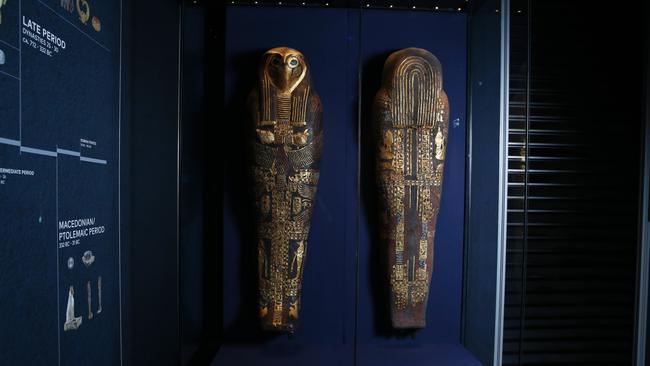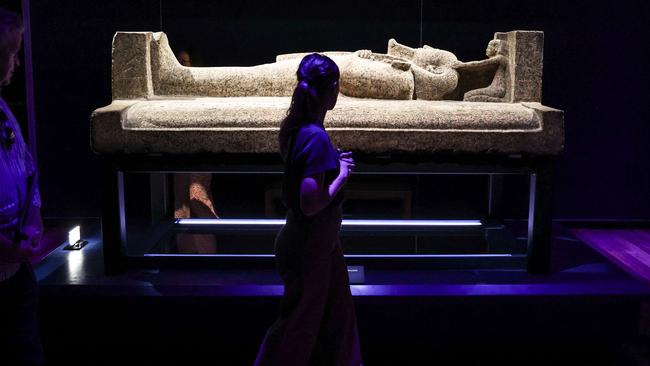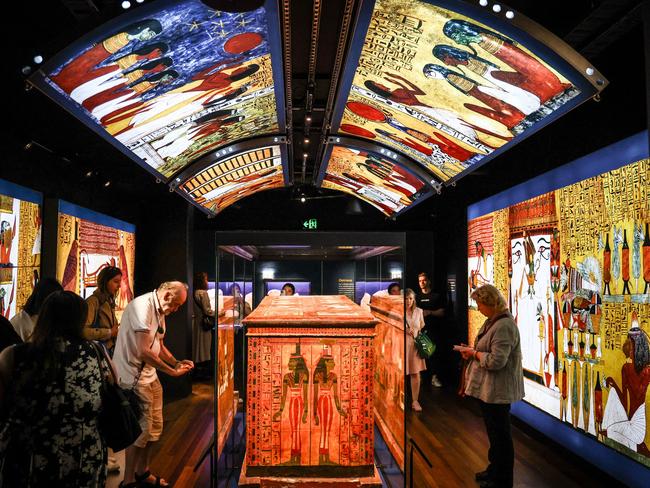Wooley: Egyptian Pharaoh Ramses’ great rule is a model for future tyrants
The difference between the ancient Egyptian pharaoh Ramses and modern dictators is the control he exerted over his own historical legacy, writes Charles Wooley

Opinion
Don't miss out on the headlines from Opinion. Followed categories will be added to My News.
I spent three days last week in our oldest and surely our best museum, the Australian Museum, in Sydney.
Travelling back in deep time to the 13th Century BC in Ancient Egypt, back to the very beginning of human civilisation, I was getting to know Ramses the Great.
The latest AM exhibition, Ramses and the Gold of the Pharaohs, opened last weekend and has already sold 100,000 tickets. Running from November 19 until May 19, 2024, with the expectation of selling as many as a million tickets.
Admittedly, not as many Australians as are going to see Taylor Swift. But in 3000 years, if we are still around, Ramses will be remembered.
Ramses, the greatest of Ancient Egypt’s 170 pharaohs, has so far proven to be history’s ultimate symbol of power and wealth.

He created the world’s first superpower, pushing back the frontiers of his domain to create a vast empire and unimaginable wealth. He created and led an all-conquering army of 100,000 men. Those whom he couldn’t defeat he incorporated. In 1274BC Ramses negotiated the world’s first international peace treaty with his most powerful enemy, the Hittite empire.
A replica of that treaty is enshrined on the wall of the United Nations Building in New York.
“The land of Egypt and the land of the Hittites will be in peace and brothers forever in accordance with the relationship of brotherhood and peace between us.”
Three thousand years later Ramses’ diplomatic skills are again required on the Egyptian border.

Ramses is best known as history’s foremost Egyptian, designer/architect who planned many great cities and temples. He claimed a godlike status, placing statues of himself in many temples and even adding scenes in which he is depicted worshipping himself. The world’s first grand master of political spin, one of his many great statues bore the self-aggrandising description famously translated by the English poet Percy Bysshe Shelley in 1818.
“My name is Ozymandias, King of Kings.
Look on my Works, ye Mighty and despair!”
Shelley of course took his own sceptical view of Ramses’ bid for immortality by depicting the pharaonic statue in ruins, in this concluding verse.
“Nothing beside, remains. Round the decay
Of that colossal wreck, boundless and bare
The lone and level sands stretch far away.”

Shelley could have had no idea just how successfully Ramses’ fame would endure, achieving the great pharaoh’s dreams of worldly immortality.
As a visit to the Australian Museum will convince you, Ramses is uncontestably the King of Kings and the Pharaoh of all Pharaohs.
Ramses’ huge sarcophagus has been shipped to Sydney and I was alone with it at the very same time President Joe Biden was refusing to resile from the use of the term “dictator” to describe China’s President Xi Jinping.
In the quiet sanctity of the museum I was reminded, as any student of history constantly should be, that in human affairs nothing really changes. As the French writer Jean-Baptiste Karr put it in 1849, “plus ca change plus c’est la meme chose” – the more things change the more they stay the same.”
Of course, Xi is a dictator. Where is the opposition?
So too was Ramses an absolute ruler and a role model for all the tyrants who would follow. He reigned for 67 years, designing a bureaucracy which gave him a level of control over his diverse empire and its peoples. His rule and his enduring influence still provides a masterclass for a succession of lesser despots.
Still, it couldn’t have been an easy life. His mummy revealed he had terrible dental problems.
He also had the mixed blessing of more than 200 wives, many representing diplomatic alliances with other nations, and he fathered more than 100 children.

The records suggest he loved them all and the tragedy of his life was that so many of his kids predeceased him.
The difference between Ramses and modern dictators is the control he exerted over his own historical legacy. With hieroglyphics and the written record, the Egyptians invented history. Ramses took management of his story for all time. He may well have had as bad a human rights record as any modern Chinese dictator, but because he wrote the only book there is nothing uncomplimentary. Modern dictators can only keep secrets from their own people and not forever.

Hollywood has portrayed Ramses as the Pharaoh of the biblical Book of Exodus. He was played as the cruel and despotic leader over whom Moses prevailed when he led the Children of Israel out of their Egyptian captivity.
Talking with the experts this week there is no real record of the Hebrew God’s intervention in human affairs to part the waters of the Red Sea and allow safe passage for the escapees.
And certainly, no evidence that Yul Brynner’s Ramses was the same guy whose army pursued Charlton Heston’s Moses in that 1956 schlock adventure thriller, The Ten Commandments.
History and mythology are most often very diverse accounts and confusing them is not just unhelpful but can have the direst long-term consequences.
The Ramses show comes to Sydney with more than 180 priceless artefacts. It includes interactive displays and what the AM calls a “thrilling” virtual reality experience. “Unnerving”, I thought would be a more accurate word when I came face-to-face with Ramses’ mummy.

The physical treasure trove of jewellery and golden objects, including some fascinating mummified cats, is insured, I am told, for well over a billion dollars.
But the museum’s chief executive, Kim McKay, the woman responsible for this incredible coup, says that’s just a number.
“No one knows the real value of these pieces. They will never be tested in the marketplace because they will never be sold.
“They are quite literally priceless and that’s the greatest value in the world.”
Take the kids to Ramses and the Gold of the Pharaohs.
For more information: https://australian.museum/exhibition/ramses/
Charles Wooley is a Tasmanian-based journalist





